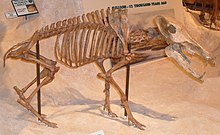Mylohyus
It has been suggested that Long-nosed peccary be merged into this article. (Discuss) Proposed since September 2024. |
| Mylohyus | |
|---|---|

| |
| M. nasutus, Texas Science & Natural History Museum | |
| Scientific classification | |
| Domain: | Eukaryota |
| Kingdom: | Animalia |
| Phylum: | Chordata |
| Class: | Mammalia |
| Order: | Artiodactyla |
| Family: | Tayassuidae |
| Genus: | †Mylohyus Cope, 1869 |
| Species | |
| |

Mylohyus is an extinct genus of peccary found in North and Central America. It first evolved during the Late Miocene and became extinct at the end of the Pleistocene, around 12,000 years ago, during the Late Pleistocene megafaunal extinction.
Six species were known, the most famous being Mylohyus nasutus, also known as the long-nosed peccary. The genus was slightly larger-bodied than any modern peccaries, with an estimated mass of 68 kg (150 lb).[1]
Isotope and anatomical studies have suggested that the diet of Mylohyus varied over geological time, from being primarily a C3 browser during the Blancan, with an increasing consumption of C4 vegetation during the Irvingtonian, with a relatively even mixture of C3 and C4 during the Rancholabrean. Suggestions have been made that it was frugivorous and also consumed hard browse like twigs.[2] Mylohyus was able to coexist with close phylogenetic relatives because of efficient niche partitioning between it and other genera of peccaries.[3]
Sources
[edit]- ^ The Paleobiology Database: Mylohyus
- ^ Bradham, Jennifer L.; DeSantis, Larisa R.G.; Jorge, Maria Luisa S.P.; Keuroghlian, Alexine (June 2018). "Dietary variability of extinct tayassuids and modern white-lipped peccaries ( Tayassu pecari ) as inferred from dental microwear and stable isotope analysis". Palaeogeography, Palaeoclimatology, Palaeoecology. 499: 93–101. Bibcode:2018PPP...499...93B. doi:10.1016/j.palaeo.2018.03.020. S2CID 134099913. Retrieved 6 February 2024.
- ^ DeSantis, Larisa R. G.; Feranec, Robert S.; MacFadden, Bruce J. (3 June 2009). Moen, Jon (ed.). "Effects of Global Warming on Ancient Mammalian Communities and Their Environments". PLoS ONE. 4 (6): e5750. Bibcode:2009PLoSO...4.5750D. doi:10.1371/journal.pone.0005750. ISSN 1932-6203. PMC 2684586. PMID 19492043.
External links
[edit]
- Pages using the JsonConfig extension
- Pliocene Artiodactyla
- Pliocene mammals of North America
- Pleistocene Artiodactyla
- Pleistocene mammals of North America
- Pliocene first appearances
- Holocene extinctions
- Fossil taxa described in 1869
- Taxa named by Edward Drinker Cope
- Prehistoric Artiodactyla genera
- Prehistoric Artiodactyla stubs

